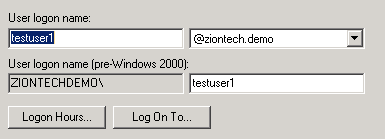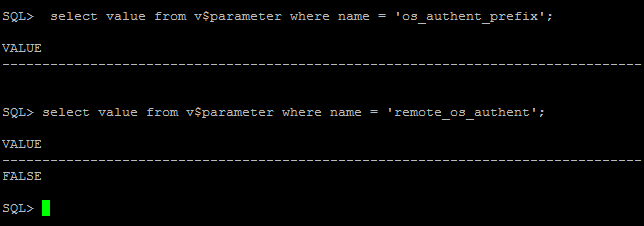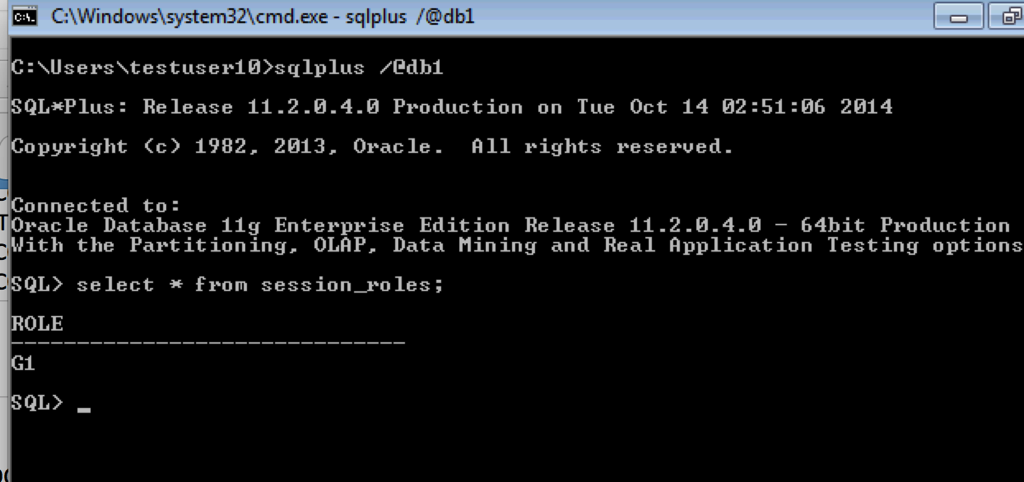Configuring Kerberos Authentication for Databases with Oracle Unified Directory (OUD)
Use Case:
Centralized user authentication and authorization for the Oracle Databases with the following requirements:
- Use the existing Microsoft Active Directory for centralized authorization i.e., role management
- Should NOT require changes to Active Directory schema
- Should NOT require placing any DLLs on Active Directory domain controllers
- Should NOT synchronize user data to another directory
Solution
For above use case, the solution is to configure databases for Kerberos authentication and deploy the Oracle Unified Directory (OUD) proxy for AD with Enterprise User Security for authorization.
Step by step process:
Topology
Active Directory & Kerberos Server (Microsoft KDC):
- Host name: addemo1.ziontech.demo
- Microsoft Windows Server 2008 R2 Enterprise Edition with Service Pack 1
- Active Directory (incorporating Kerberos Key Distribution Centre (KDC))
- Realm name: ziontech.demoRealm name: ziontech.demo
Oracle Unified Directory:
- Host name: oud.ziontech.demo
- 11.1.2.2.0 version running on Oracle Enterprise Linux 6
Oracle Database:
- Host name: db1.ziontech.demo
- Oracle Enterprise Linux 6Oracle Enterprise Linux 6
- Oracle11g R2 Server Enterprise Edition 11.2.0.4with Oracle Advanced Security Option (ASO)
Oracle Client:
- Host name: win7a.ziontech.demo
- Microsoft Windows 7 64 bitMicrosoft Windows 7 64 bit
- Oracle11g R211.2.0.4 64 bit Client installation with Oracle Advanced Security Option (ASO)
Section 1: On AD machine
1.1 Create two users (principals in Kerberos terminology)
testuser1, which will be used to connect to DB from client
Second for Oracle DB server,
→ Check password never expires option for sever principal Check password never expires option for sever principal
- The ‘First Name’ is the fully qualified domain name of the machine the Oracle server is running on. The ‘Full Name’ will automatically be filled in.The ‘Full Name’ will automatically be filled in.
1.2 Create Key Table in Windows 2008 R2
The final step on the Windows 2008 R2 server is to extract a key table for the database server principal. This is done using the ktpass tool.
ktpass.exe -princ oracle/db1.ziontech.demo@ZIONTECH.DEMO -mapuser ZIONTECHDEMO\db1.ziontech.demo -crypto all -pass Welcome9 -out c:\keytab
The resulting keytab file should then be transferred to the machine running Oracle
There is a process on how to validate keytab (read this post). Using this approach, we can avoid lot of troubleshooting upfront by ensuring that the KVNO value is compatible.
As mentioned in above referenced post, perform following ldapsearch query to obtain msDS-KeyVersionNumber from Active Directory.
ldapsearch -h ad.ziontech.demo -p 389 -D "testuser1@ziontech.demo" -w "Welcome1" -b "DC=ziontech,DC=demo" -s sub servicePrincipalName=oracle/db1.ziontech.demo msDS-KeyVersionNumber
The output will look like:
CN=db1,CN=Users,DC=ziontech,DC=demo msDS-KeyVersionNumber=6
Then, increment value of msDS-KeyVersionNumber by 1 and pass it as a value to the parameter -kvno in ktpass command.
We can even specify specific supported algorithm(s) for crypto parameter and use this version of ktpass instead of above.
ktpass.exe -princ oracle/db1.ziontech.demo@ZIONTECH.DEMO -mapuser ZIONTECHDEMO\db1.ziontech.demo -crypto AES256-CTS-HMAC-SHA1-96 -pass Welcome9 -ptype KRB5_NT_PRINCIPAL -kvno 7 -out c:\keytab
1.3 Create a group
→ Create a group called g1 and add testuser1 to it.
Section 2: On OUD machine
2.1 Configure OUD proxy instance
2.1.1 Install JDK and OUD software. Optionally ODSM
Pretty much standard installation. Accept all defaults.
2.1.2 Invoke OUD proxy set up script:
$MW_HOME/Oracle_OUD1/oud-proxy-setup
→ Ensure, to enable SSL In server settingsEnsure, to enable SSL In server settings
→ Select Configure EUS under deployment optionsSelect Configure EUS under deployment options
→ Select Microsoft Active Directory as the backend-server typeSelect Microsoft Active Directory as the backend-server type
→ Add AD server instanceAdd AD server instance
→ Select or specify Naming ContextSelect or specify Naming Context
→ FinishFinish
2.1.3 Post Install steps
Configure the proxy workflow elements using dsconfig tool located in $MW_HOME/Oracle_OUD1/bin
dsconfig set-workflow-element-prop \ --element-name proxy-we1 \ --set remote-root-dn:CN=Administrator,CN=Users,DC=ziontech,DC=demo \ --set remote-root-password:Welcome1 \ --hostname localhost \ --port 6444 \ --trustAll \ --bindDN cn=Directory\ Manager \ --bindPasswordFile pwd.txt \ --no-prompt dsconfig set-workflow-element-prop \ --element-name proxy-we1 \ --add exclude-list:cn=directory\ manager \ --add exclude-list:cn=oraclecontext,dc=ziontech,dc=demo \ --set remote-ldap-server-bind-dn:CN=Administrator,CN=Users,DC=ziontech,DC=demo \ --set remote-ldap-server-bind-password:Welcome1 \ --hostname localhost \ --port 6444 \ --trustAll \ --bindDN cn=directory\ manager \ --bindPasswordFile pwd.txt \ --no-prompt
2.1.4 Update the realm information in the OUD configuration:
Locate the LDIF template file at $MW_HOME/Oracle_OUD1/config/EUS/modifyRealm.ldif
Edit the modifyRealm.ldif file as follows:
→ Replace dc=example,dc=com with dc=ziontech,dc=demoReplace dc=example,dc=com with dc=ziontech,dc=demo
→ Replace ou=people and ou=groups with the correct locations of the user and group entries in ADReplace ou=people and ou=groups with the correct locations of the user and group entries in AD
Use the ldapmodify command to update the configuration with the edited LDIF template file, for example:
$ ldapmodify -h localhost -p 1389 -D "cn=directory manager" -j pwd-file -f modifyRealm.ldif
2.2 Perform following changes in OUD proxy
Modify the attribute orclcommonkrbprincipalattribute in the EUS config (cn=OracleContext,<realm>) to the attribute name which stored the Kerberos principal on AD.
Additionally, I modified few other attributes.
$ ldapmodify -h localhost -p 1389 -D "cn=directory manager" -j pwd-file -f modifyConfig.ldif # cat modifyConfig.ldif dn: cn=Common,cn=Products,cn=OracleContext,dc=ziontech,dc=demo changetype: modify replace: orclCommonKrbPrincipalAttribute orclCommonKrbPrincipalAttribute: userPrincipalName - dn: cn=Common,cn=Products,cn=OracleContext,dc=ziontech,dc=demo changetype: modify replace: orclCommonWindowsPrincipalAttribute orclCommonWindowsPrincipalAttribute: samaccountname - dn: cn=Common,cn=Products,cn=OracleContext,dc=ziontech,dc=demo changetype: modify replace: orclCommonNicknameAttribute orclCommonNicknameAttribute: samaccountname -
Section 3: On DB machine
3.1 Verify that the system settings remote_os_authent=false and os_authent_prefix=”” are configured correctly:
SQL> select value from v$parameter where name = 'os_authent_prefix'; SQL> select value from v$parameter where name = 'remote_os_authent';
If you see something like ops$ for os_authent_prefix, it has to be changed to null using following process:
SQL> create pfile='/tmp/pfile.txt' from spfile; SQL> shutdown immediate;
Add this to the “/tmp/pfile.txt” file:
os_authent_prefix=''
Recreate the pfile:
SQL> sqlplus / as sysdba SQL> create spfile from pfile='/tmp/pfile.txt'; SQL> startup
3.2 Configure SQLNET for Kerberos
Modify sqlnet.ora with following configuration:
NAMES.DIRECTORY_PATH= (TNSNAMES, EZCONNECT) ADR_BASE = /app/db1 SQLNET.KERBEROS5_KEYTAB=/app/kerberos/keytab SQLNET.KERBEROS5_CONF=/app/kerberos/krb5.conf SQLNET.KERBEROS5_CONF_MIT=TRUE SQLNET.AUTHENTICATION_KERBEROS5_SERVICE=oracle SQLNET.AUTHENTICATION_SERVICES=(BEQ,KERBEROS5)
Create /app/kerberos/krb5.conf with following content:
[libdefaults]
default_realm = ZIONTECH.DEMO
[realms]
ZIONTECH.DEMO = {
kdc = addemo1.ziontech.demo:88
}
[domain_realm]
.ziontech.demo = ZIONTECH.DEMO
ziontech.demo = ZIONTECH.DEMO
3.3 Configure and Register Database for directory usage
Configure the database to use the directory:
Run netca and then,
1) Select ‘Directory Usage Configuration’
2) Set the Directory Type to ‘Oracle Internet Directory’
3) Set the Hostname, Port, and SSL Port for the OUD Server
4) Select the Oracle Context to use. In this document, the context used is “cn=OracleContext,dc=ziontech,dc=demo”
5) Click Finish.
This will create an ldap.ora file in the $ORACLE_HOME/network/admin directory with following content:
# ldap.ora Network Configuration File: /app/db1/product/11.2.0/dbhome_1/network/admin/ldap.ora # Generated by Oracle configuration tools. DIRECTORY_SERVERS= (oud.ziontech.demo:4389:4636) DEFAULT_ADMIN_CONTEXT = "dc=ziontech,dc=demo" DIRECTORY_SERVER_TYPE = OID
Registering Database with the Directory:
Run the Database Configuration Assistant (dbca) from the database Oracle Homes to register the database with OID.
Run dbca and then,
1) Click ‘Next’
2) Select ‘Configure Database Options’
3) Select the database from the list – there may then be a short delay.
4) On the Directory Service screen select ‘Yes, register the database’ and enter the username and password of an OUD user who is authorized to register databases. For example a username of ‘cn=Directory Manager’.
Then enter a password to be used for the new database wallet. This wallet is used to store a randomly generated internal password for the database.
5) Click ‘Next’, and the ‘Next’ again on the Database Components screen.
6) Finally click ‘Finished’ on the Connection Mode screen, and ‘OK’ on the pop-up Confirmation window.
3.4 Create test user and role on Database
Create user:
create user testuser1 identified globally as 'CN=testuser1,CN=Users,DC=ziontech,DC=demo'; grant create session to testuser1;
Create global role in the Database:
create role g1 identified globally;
3.5 Create mappings
These can be performed either by using Oracle Enterprise Manager or using a command line alternative tool ‘eusm’ located under $ORACLE_HOME/bin
# Create a role in Directory
eusm createRole enterprise_role=g1 domain_name="OracleDefaultDomain" realm_dn="dc=ziontech,dc=demo" ldap_host="oud.ziontech.demo" ldap_port=1389 ldap_user_dn='cn=Directory\20Manager' ldap_user_password='Welcome1'
# Map the ENT role with DB role
eusm addGlobalRole enterprise_role="g1" domain_name="OracleDefaultDomain" realm_dn="dc=ziontech,dc=demo" database_name="db1" global_role="g1" dbuser="system" dbuser_password="Welcome1" dbconnect_string="db1.ziontech.demo:1521:db1" ldap_host="oud.ziontech.demo" ldap_port=1389 ldap_user_dn='cn=Directory\20Manager' ldap_user_password='Welcome1'
# Grant Role
eusm grantRole enterprise_role="g1" domain_name="OracleDefaultDomain" realm_dn="dc=ziontech,dc=demo" group_dn="CN=g1,CN=Users,DC=ziontech,DC=demo" ldap_host="oud.ziontech.demo" ldap_port=1389 ldap_user_dn='cn=Directory\20Manager' ldap_user_password='Welcome1'
Section 4: On Client Machine
- Login to Windows 7 client as testuser1 to ZIONTECH.DEMO domain
- Since client Windows PC is a member of Active Directory Domain, and the user has logged into the Windows machine as a domain user, user should be able to connect to Oracle Database without need for Oracle client.
- Client is already installed under default location: C:\app\testuser1\product\11.2.0\client_1\
Modify sqlnet.ora to contain following information:
NAMES.DIRECTORY_PATH= (TNSNAMES, EZCONNECT) SQLNET.KERBEROS5_CC_NAME=OSMSFT:// SQLNET.AUTHENTICATION_SERVICES= (beq,kerberos5) SQLNET.KERBEROS5_CONF =c:\kerberos\krb5.conf SQLNET.KERBEROS5_CONF_MIT = true
Create krb5.conf in the location defined above:
SQLNET.KERBEROS5_CC_NAME=c:\kerberos\cc SQLNET.AUTHENTICATION_SERVICES= (beq,kerberos5) SQLNET.KERBEROS5_CONF =c:\kerberos\krb5.conf SQLNET.KERBEROS5_CONF_MIT = true
Create tnsnames.ora
DB1 = (DESCRIPTION = (ADDRESS = (PROTOCOL = TCP)(HOST = db1.ziontech.demo)(PORT = 1521)) (CONNECT_DATA = (SERVER = DEDICATED) (SERVICE_NAME = db1.ziontech.demo) ) )
Connect to Database using SQLplus.
User is automatically logged on to database as Oracle Client uses the internal Windows credentials cache.
Global role is assigned as expected






Leave A Comment